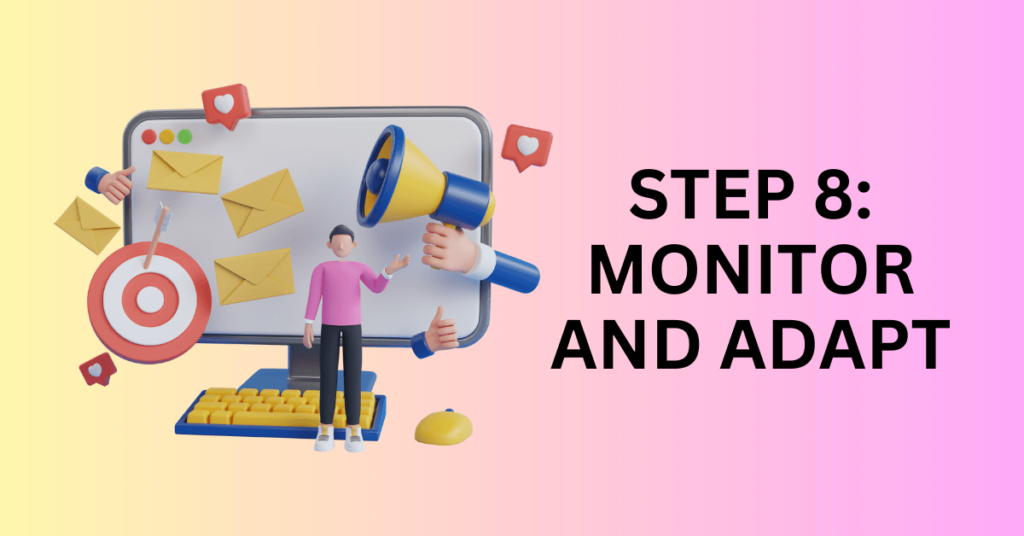Building a personal brand has become more crucial than ever. A well-crafted personal brand not only establishes your authority and credibility in your niche but also sets you apart from the competition. But how can you build a personal brand that truly resonates with your audience in this digital age?
Building a personal brand can open up new opportunities, help you connect with your target audience on a deeper level, and ultimately lead to professional success.
In this comprehensive guide, we’ll walk you through eight simple steps to help you build a powerful and authentic personal brand in 2023.
Step 1: Define Your Brand Identity

The first step in building a personal brand is to define your brand identity. Your brand identity is the essence of who you are and what you represent. Start by asking yourself some fundamental questions.
- What are your core values?
- What is your mission or purpose?
- What sets you apart from others in your field?
Your answers to these questions will serve as the foundation of your personal brand. Once you’ve clarified your brand identity, it’s crucial to ensure consistency across all your online and offline channels.
This includes your website, social media profiles, email signature, and even your personal interactions. Consistency breeds trust and helps your audience recognise and remember your brand.
Next, consider the visual elements of your brand. Your logo, colour scheme, and typography should all align with your brand identity. These elements should be used consistently in your online presence, from your website design to your social media graphics.
By maintaining a cohesive visual identity, you’ll create a more memorable and professional impression on your audience.
Step 2: Identify Your Target Audience

To build a personal brand that resonates with your audience, you must understand who they are. Identifying your target audience is crucial because it allows you to tailor your content, messaging, and branding efforts to their specific needs and preferences.
You can start by creating detailed buyer personas. The fictional representations of your ideal customers. Consider demographics, psychographics, pain points, and goals.
Once you’ve crafted these personas, you can use them as a guide for creating content that speaks directly to your target audience.
Furthermore, it’s essential to research your competitors and their audiences. By analyzing what works for others in your niche, you can gain insights into the type of content and branding that appeals to your target audience.
Social media platforms and analytics tools provide valuable data to help you understand your audience’s behaviour and preferences. Regularly review these insights and adjust your strategies accordingly to stay relevant and engaging to your target audience.
Step 3: Create High-Quality Content

Content is at the heart of personal branding. Creating high-quality content that provides value to your audience is essential for building trust and authority. Your content should reflect your brand identity and resonate with your target audience.
Start by developing a content strategy that outlines the topics, formats, and channels you’ll use to reach your audience. This strategy should align with your brand identity and cater to the interests and pain points of your target audience.
When it comes to content creation, consistency is key. Whether you’re blogging, vlogging, podcasting, or using social media, maintain a regular posting schedule. Consistency helps keep your audience engaged and builds anticipation for your content.
Additionally, aim for authenticity in your content. Share your unique perspective and personal experiences. Authenticity fosters a deeper connection with your audience and sets you apart from others in your niche.
Incorporate a variety of content formats to cater to different preferences within your target audience. This could include written articles, videos, infographics, webinars, and more.
Finally, you should experiment with different formats and analyze their performance to determine what resonates most with your audience.
Read more on how to start with content marketing
Step 4: Leverage Social Media to Build a Personal Brand

In the digital age, social media plays a pivotal role in personal branding. It provides a platform to connect with your audience, showcase your expertise, and build your online presence.
First, you should start by choosing the social media platforms that align with your target audience and content format. For example, if you create visually appealing content, platforms like Instagram and Pinterest may be more suitable. On the other hand, if you produce informative content, LinkedIn and Twitter could be a better fit.
Then, optimize your social media profiles to reflect your brand identity. Use a consistent profile picture and cover photo, and write a compelling bio that communicates who you are and what you do.
You should also share your content, engage with your audience regularly through comments and messages, and participate in relevant conversations within your niche. Be authentic and genuine in your interactions, as this will help you build trust and credibility with your followers.
Then, consider using social media scheduling tools to plan and automate your posts, ensuring a consistent online presence even during busy times. Finally, monitor your social media analytics to track the performance of your content and adjust your strategy based on the data.
Building a personal brand on social media takes time and effort, but it can yield significant rewards in terms of visibility and engagement.
Learn more about the Complete Social Marketing Strategy Guide
Step 5: Network and Collaborate to Build a Personal Brand

Networking is a powerful tool for building a personal brand. Establishing meaningful connections within your industry can open doors to new opportunities, collaborations, and increased visibility. Besides, you can attend industry conferences, webinars, and networking events, both online and offline.
This will enable you to build a new network by meeting like-minded professionals and potential collaborators. In addition, you can join relevant LinkedIn groups and participate in discussions to showcase your expertise and connect with industry peers.
Collaborating with others in your niche can help you reach a wider audience and strengthen your personal brand. Look for opportunities to co-create content, such as guest blog posts, podcast interviews, or joint webinars. Collaborations allow you to tap into the existing audiences of your partners and gain credibility by association.
In addition to industry-specific networking, consider building relationships with influencers and thought leaders in your field. Engage with their content, share their insights, and reach out for collaborations or mentorship opportunities.
Building a strong professional network is an ongoing process that can significantly enhance your personal brand’s reach and impact.
Step 6: Showcase Your Expertise to Build a Personal Brand

Establishing yourself as an expert in your field is a key element of personal branding. To do this, you must consistently showcase your knowledge and expertise.
Start by creating and sharing in-depth, informative content that addresses common challenges and questions within your niche. Write articles, create tutorials, or record webinars that demonstrate your expertise and provide value to your audience.
In addition, you can consider publishing a book, e-book, or whitepaper on a topic related to your field. This not only positions you as an authority but also provides a tangible asset that can be used to further your personal brand.
Additionally, seek opportunities to speak at industry conferences or webinars, where you can share your insights and expertise with a broader audience.
Don’t underestimate the power of personal branding through certifications and credentials. If applicable to your field, earning relevant certifications or degrees can enhance your credibility and authority. Display these qualifications prominently on your website and social media profiles.
Finally, remember that consistency is key when showcasing your expertise. Regularly update your content and stay informed about the latest developments in your field. Share your thoughts and opinions on industry trends to demonstrate your ongoing commitment to your niche.
Step 7: Build a Professional Website to Build a Personal Brand

In the digital era, your website is often the first impression you make on potential clients, employers, or collaborators. A professional website is an essential component of personal branding.
Step-by-Step Guide: How To Build and Launch Your Personal Website
You can do it by first, selecting a domain name that reflects your brand identity and is easy to remember. Then, design a clear and user-friendly website that aligns with your brand’s visual identity.
Then, get your web hosting service and choose the platform to build your website. If you are building your website on WordPress, you will need to get your own hosting service. But if you are building it on a website builder like Wix, the web hosting is taken care of by Wix.
Next, create a compelling “About Me” or “About Us” page that tells your story, communicates your values, and highlights your expertise. You should also include a professional headshot and a concise bio that captures the essence of your personal brand.
Showcase your best work, whether it’s a portfolio of projects, case studies, or testimonials from satisfied clients or employers. This can increase your credibility.
Regularly update your website with fresh content, such as blog posts, articles, or news updates. This not only demonstrates your expertise but also improves your website’s search engine ranking, making it easier for others to find you online.
Ensure that your website is mobile-responsive, as many users access websites from smartphones and tablets.
Invest in search engine optimization (SEO) to improve your website’s visibility on search engines like Google. Use relevant keywords in your content, optimize your images, and ensure fast loading times.
An SEO-optimized website can drive organic traffic and further establish your online presence.
Step 8: Monitor and Adapt

Building a personal brand is an ongoing process that requires monitoring and adaptation. Regularly assess the effectiveness of your branding strategies by tracking key metrics such as website traffic, social media engagement, and audience growth.
Use analytics tools to gain insights into what’s working and what isn’t.
Seek feedback from your audience and peers to gain an outside perspective on your personal brand. Listen to constructive criticism and be open to making adjustments to better align with your brand identity and audience expectations.
Stay informed about the latest trends and developments in your field and the digital marketing landscape as a whole. The digital environment is constantly evolving, and staying up-to-date will ensure that your personal brand remains relevant and competitive.
Final Thoughts – How to Build a Personal Brand in 8 Simple Steps
Building a personal brand is more important than ever for digital marketers and professionals in various fields. A strong personal brand can help you stand out, connect with your target audience, and create new opportunities for growth and success.
By following these eight simple steps, you can establish and nurture a personal brand that is authentic, influential, and aligned with your goals. Remember that building a personal brand is an ongoing journey, and with dedication and consistency, you can continue to refine and expand your brand’s impact in the digital age.





